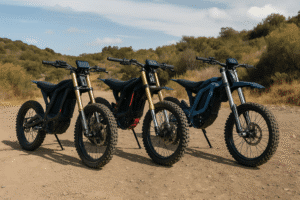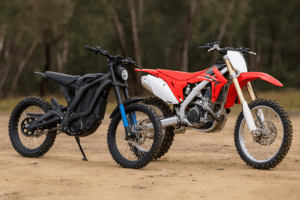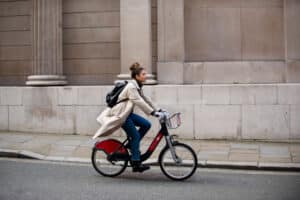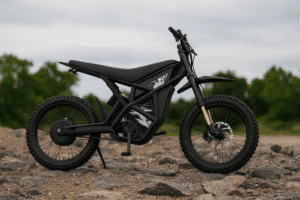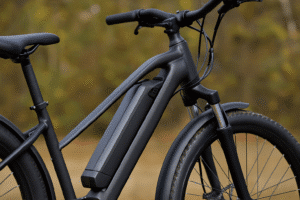A 1000W e-bike isn’t your average commuter ride; it’s a powerhouse. With top speeds between 28 and 35 mph, these bikes blur the line between an electric bicycle and a light motorcycle.
In the U.S., where most street-legal e-bikes cap at 750W, 1000-watt models are turning heads for their raw power, speed, and off-road potential.
But before you hit those speeds, it helps to know what that wattage really means, what’s legal, and how to ride safely.
Key Summary:
- A 1000W e-bike can reach 28–35 mph (up to 40 mph downhill).
- Real-world speeds vary with rider weight, terrain, and battery voltage.
- In most U.S. states, 1000W exceeds the legal street limit of 750W.
- Best for off-road riding, hills, or long commutes, not ideal for city bike lanes.
How Fast Does A 1000W E-Bike Go?
A 1000W electric bike can go as fast as 35 to 40 mph, but most riders see real-world speeds around 28 to 32 mph on flat roads. The top speed depends on things like rider weight, terrain, and whether you’re using pedal assist or throttle.
These bikes are much faster than standard e-bikes in the 250W to 750W range. They have more torque, which means quicker acceleration and better climbing power too. That makes them popular for people who want something powerful for off-roading, hills, or longer commutes.
But just because the bike can go that fast doesn’t mean you’ll always ride at full speed. Traffic, weather, road conditions, and battery level all play a role.
And in many places, there are legal speed limits you’ll need to follow, especially if you’re riding on public roads.
If you’re thinking about unlocking your e-bike’s full speed, here’s a simple guide on how to derestrict an electric bike safely and legally.
What Does “1000W” Actually Mean?
The term “1000W” refers to the power output of the electric motor, measured in watts. It tells you how strong the motor is. A 1000-watt motor is considered high-power for an e-bike, and it’s much more powerful than the more common 250W or 500W motors.
But wattage alone doesn’t tell the whole story. You also have to look at whether that number is the bike’s nominal power (its normal running power) or peak power (the highest power it can hit in short bursts). Some motors advertise 1000W as a peak rating when they actually run at 750W most of the time.
The motor’s efficiency, the quality of the controller, and how the power is delivered all play a part. Two 1000W bikes might ride very differently depending on how they’re built and tuned.
It’s also worth noting that more watts usually mean faster acceleration and better performance going uphill, but they also use more battery power and can be heavier.
Factors That Affect 1000W E-Bike Speed
Even with a strong motor, your actual speed can change depending on several things. Here are the key factors that make a difference:
Motor Type
There are three main types of motors found on 1000W e-bikes: hub motors (direct drive or geared) and mid-drive motors.
Mid-drive motors usually give better climbing power and a more natural pedal feel, especially on hills. Hub motors are simpler and often found on more affordable models.
Mid-drive setups tend to be more efficient and better at handling varied terrain, which can affect both speed and control.
Battery Specs
The voltage and capacity of your battery have a big impact on how fast and how far your e-bike can go. A 48V or 52V battery paired with a 1000W motor delivers more power than a lower voltage system.
Higher amp-hours (Ah) and watt-hours (Wh) mean longer rides and better performance at higher speeds. If your battery is running low, you might notice your top speed drops too.
Rider Weight And Cargo
The more weight the bike has to move, the harder the motor has to work. A lighter rider will usually get faster speeds and better acceleration compared to someone heavier or carrying cargo.
If you’re pulling a trailer, hauling groceries, or just wearing a heavy backpack, that extra load can make a real difference in speed and range.
Read more: Best electric bike for a 400 lb person
Terrain And Riding Conditions
Riding on a smooth, flat road is always going to be faster than trying to pedal up a steep hill or ride through mud or gravel. Wind also plays a role. If you’re riding into a headwind, even a strong motor can feel sluggish.
Downhill, you might see speeds well over 35 mph. But uphill, expect things to slow down, sometimes dramatically, depending on the grade.
Assist Mode Or Throttle Use
Most 1000W e-bikes have multiple assist modes like Eco, Normal, and Turbo. The more assist you use, the faster you’ll go, but the battery will drain quicker too.
If your bike has a throttle, you can hit high speeds without pedaling, but again, it burns through power fast. Riding in pedal-assist mode usually gives you a better balance of speed and efficiency.
Tire Size And Pressure
Fat tires create more rolling resistance, which can slow you down a bit. But they’re great for comfort and off-road grip. Narrow tires are better for speed on pavement.
Tire pressure also matters. Lower pressure gives a smoother ride but can reduce your top speed. Keeping your tires properly inflated helps maintain good speed and battery efficiency.
How Fast Can You Really Expect To Go?
Your actual speed on a 1000W e-bike will vary based on how you’re riding and where. Here’s a quick look at how different assist modes and conditions can affect your ride:
| Riding Mode / Condition | Speed Range (mph) | Notes |
|---|---|---|
| Eco Mode | 12–15 mph | Best for saving battery and long rides |
| Normal Mode | 15–20 mph | Good balance of speed and efficiency |
| Sport Mode | 20–28 mph | Great for commuting and moderate hills |
| Turbo Mode | 28–35+ mph | Max power for steep climbs or open roads |
| Flat Terrain | 25–32 mph | Smooth roads allow higher average speed |
| Uphill | 10–18 mph | Depends on incline and assist level |
| Downhill | 30–40+ mph | Gravity gives a major boost here |
Is a 1000W E-Bike Legal?

A 1000W e-bike is not legal on public roads in many places without proper registration or a special license. In the U.S., most states allow up to 750W for street use. Anything above that may fall outside standard e-bike classes.
In general, Class 1, 2, and 3 e-bikes are limited to 750 watts. These are the ones allowed on bike paths, sidewalks, and public roads. Since a 1000W motor exceeds that limit, it’s usually considered Class 4 or an “unclassified vehicle,” which may require insurance, registration, and a helmet by law.
Some areas are stricter than others. For example, California and New York have more defined e-bike laws, while other states are still catching up. Off-road use is usually fine, but it’s smart to check local laws before hitting the street.
If you’re using your e-bike only on private land or trails, you probably won’t run into legal issues. But for commuting or street riding, it’s best to double-check whether your 1000W setup is street-legal in your area.
How Fast Does Each Motor Size Go?
A higher motor wattage generally means faster acceleration and better performance on hills. While smaller 250W and 500W motors are ideal for city commutes, 750W and 1000W models can reach highway-like speeds on open roads.
The chart below shows how each common e-bike motor size performs in real-world conditions.
| Motor Power | Typical Top Speed (mph) | Best For |
|---|---|---|
| 250W | 15–17 | Short city rides, flat terrain |
| 500W | 18–25 | Commuting, moderate hills |
| 750W | 25–28 | Steeper terrain, heavier riders |
| 1000W | 28–40+ | Off-road trails, long climbs, high-speed use |
Is 1000W Too Much Power For City Riding?
For most city riders, a 1000W e-bike is more power than they actually need. In everyday situations like stop-and-go traffic, short commutes, or flat roads, something in the 500W–750W range is usually enough.
That said, 1000W can be helpful if your city has lots of steep hills or if you carry a lot of cargo. It also gets you up to speed quickly, which can be useful in busy intersections or for getting ahead of traffic. But in tight bike lanes or crowded areas, the extra speed may feel like overkill.
If you’re just looking for a smooth, simple ride around town, a smaller motor might save you money and still get the job done well.
Off-Road And Adventure Use: Where 1000W Shines
This is where 1000W really makes sense. The extra torque and higher top speed help you climb hills, tackle rough trails, and carry gear without breaking a sweat.
Some of the advantages include:
- Hill Climbing Power – More watts = easier climbs on steep or loose terrain
- Better Handling On Tough Trails – Great for gravel, sand, mud, or forest paths
- Extra Load Support – Ideal for carrying camping gear, fishing rods, or trailers
- Faster Trail Riding – Gives a fun boost of speed on open trails or fire roads
- Confidence On Long Rides – The motor won’t struggle, even with a heavy battery pack
If you’re the kind of rider who likes exploring off the beaten path, a 1000W e-bike gives you the freedom and strength to go just about anywhere.
Read more: Best electric dirt bike for adults
Safety Tips For Riding At High Speeds
Riding a 1000W e-bike means higher speeds, which calls for extra caution. Here are a few simple safety tips to keep in mind:
- Always Wear A Helmet – Make sure it fits well and is certified for bike use
- Use Mirrors And Lights – Being seen and aware of traffic is key
- Check Your Brakes – At 30+ mph, you need strong, well-maintained brakes
- Avoid Riding In Bad Weather – Wet roads and high speeds don’t mix well
- Start Slow If You’re New – Get used to the power before you crank it up
- Don’t Ride Distracted – Keep both hands on the bars and eyes on the road
Final Words
A 1000W e-bike is built for power, speed, and performance. Under ideal conditions, it can hit speeds between 35 to 40 mph, but most riders will cruise somewhere between 25 to 32 mph on flat terrain. That’s more than enough for long commutes, steep hills, or trail riding.
Just remember, how fast you actually go depends on more than just the motor. Things like your weight, terrain, battery size, and even tire pressure play a role. And of course, laws vary by region, so always check what’s allowed in your area before taking it on public roads.
If you’re riding in the city, 1000W might be more power than you need. But for off-road adventures, hilly commutes, or hauling extra gear, it can make a big difference. As long as you ride safely and smartly, a 1000W e-bike can give you a fast and fun way to get around.
FAQs
Yes, a 1000W e-bike handles hills with ease thanks to its strong torque and higher power output. Riders can usually maintain 15–20 mph on moderate inclines without much effort, especially when using pedal assist.
Yes, higher-powered motors draw more current, which means they use more battery per mile. However, if you ride efficiently in pedal-assist mode and avoid constant full-throttle use, you can still get solid range from a large-capacity battery.
It’s only safe if done correctly and ridden in the right setting. Removing speed limits can increase wear on the motor and brakes and may make your e-bike illegal for public roads, so it’s best reserved for private property or off-road use.
Al Amin Morshed is the founder of BoltBikers and a seasoned e-bike reviewer with years of hands-on experience testing electric bikes. As a long-time e-bike enthusiast, he combines real-world riding insights with in-depth research to create honest, helpful content for riders of all levels. Through BoltBikers, Morshed aims to make e-biking more accessible, practical, and enjoyable – whether you’re a new rider or a daily commuter looking for the best gear.
